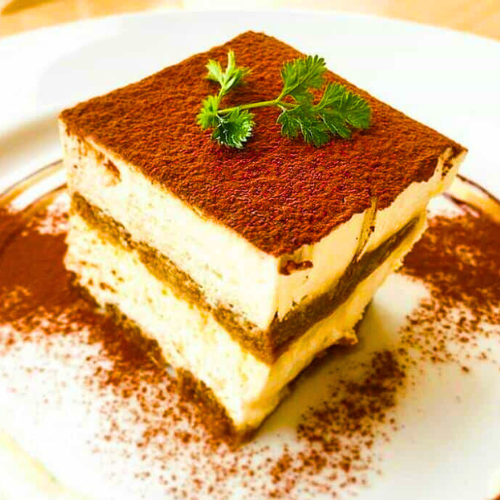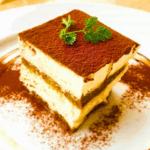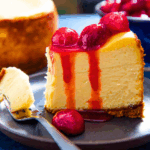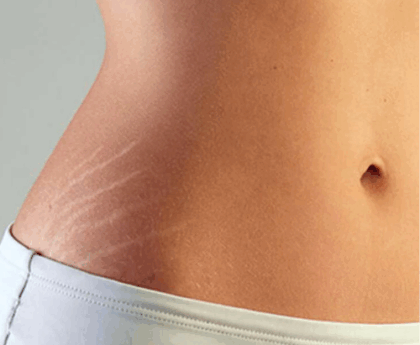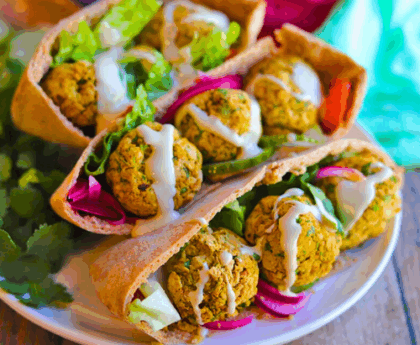What Is Tiramisu Traditionally Made Of? The Complete Guide
What Is Tiramisu Traditionally Made Of? Tiramisu is one of the most beloved and iconic desserts to emerge from Italy, renowned for its rich yet delicate flavors and layered texture. But what exactly is tiramisu traditionally made of? This question is often asked by food enthusiasts, home bakers, and even professional chefs seeking authenticity in their creations. In this comprehensive guide, we’ll explore the traditional ingredients of tiramisu, the history behind this famous dessert, variations that have emerged over time, and much more.
What Is Tiramisu?
Tiramisu is a classic Italian dessert typically served chilled, composed of layers of coffee-soaked ladyfinger biscuits (savoiardi), a rich mascarpone cheese mixture, and dusted with cocoa powder. Its name, “tiramisu,” translates to “pick me up” or “cheer me up,” which aptly describes both its caffeine content and its delightful flavor.
Originating in Italy in the 20th century, tiramisu has become a global favorite, appearing on menus from New York to Tokyo. Yet despite its popularity, many people are unclear about what tiramisu is traditionally made of, especially given the many modern variations.
The Traditional Ingredients of Tiramisu
1. Ladyfinger Biscuits (Savoiardi)
At the heart of traditional tiramisu are ladyfinger biscuits, known in Italian as savoiardi. These light, airy sponge biscuits are essential for providing the structural layers of the dessert.
Key characteristics:
- Crisp and dry texture to absorb the coffee mixture without becoming overly soggy.
- Slightly sweet flavor that complements the bitterness of coffee.
Why savoiardi?
Their sponge-like quality allows them to soak up liquid while maintaining enough firmness to support the mascarpone layers.
2. Espresso Coffee
Authentic tiramisu is made with strong Italian espresso, giving the dessert its signature coffee flavor and a subtle caffeine kick.
Important details:
- Freshly brewed espresso is ideal for the most authentic taste.
- Typically cooled to room temperature before soaking the ladyfingers.
- Occasionally, a dash of liquor is added to the espresso for extra complexity.
Why espresso?
Espresso’s bold, concentrated flavor cuts through the richness of the mascarpone and eggs, balancing the dessert’s profile.
3. Mascarpone Cheese
Mascarpone is a rich, creamy Italian cheese made from heavy cream and citric acid or lemon juice. It is an indispensable ingredient in traditional tiramisu.
Key characteristics:
- Silky smooth texture.
- Mild, slightly sweet flavor.
Why mascarpone?
Its luxurious creaminess is essential for the filling, creating a luscious texture that distinguishes tiramisu from other layered desserts.
4. Eggs
Traditional tiramisu relies on fresh, raw eggs, both yolks and whites, incorporated separately.
How eggs are used:
- Egg yolks are whisked with sugar to create a thick, pale zabaglione (Italian egg custard).
- Egg whites are beaten until stiff peaks form and then folded into the mascarpone mixture to add lightness and volume.
Safety note:
Because traditional tiramisu uses raw eggs, it’s crucial to use pasteurized eggs or source them from reputable suppliers to minimize the risk of salmonella.
5. Sugar
Granulated white sugar is typically used in traditional tiramisu, added to the egg yolks and mascarpone to balance the bitterness of the coffee and cocoa.
Purpose:
- Sweetens the mascarpone mixture.
- Enhances overall flavor.
6. Cocoa Powder
The finishing touch of traditional tiramisu is a generous dusting of unsweetened cocoa powder.
Why cocoa powder?
Its bitter edge harmonizes beautifully with the coffee-soaked ladyfingers and creamy mascarpone, completing the dessert’s flavor profile.
7. Optional: Alcohol (Marsala Wine or Coffee Liqueur)
Though not strictly required, many traditional Italian recipes incorporate a splash of Marsala wine or a coffee liqueur such as Kahlúa or Tia Maria into the espresso for added depth.
Why include alcohol?
- Adds complexity and enhances the coffee flavor.
- Marsala imparts subtle nutty, sweet notes.
Some purists argue that alcohol-free tiramisu is the most authentic, while others maintain that Marsala is part of the traditional preparation.
How Traditional Tiramisu Is Assembled
- Prepare the espresso and allow it to cool. Optionally mix with Marsala or liqueur.
- Whisk egg yolks with sugar until thick and pale.
- Fold mascarpone into the egg mixture.
- Beat egg whites until stiff and fold into the mascarpone mixture for a light, airy consistency.
- Dip the ladyfingers briefly in the coffee mixture.
- Layer the soaked ladyfingers in a dish.
- Spread the mascarpone mixture evenly over the ladyfingers.
- Repeat the layers, finishing with the mascarpone.
- Dust with cocoa powder before chilling.
- Refrigerate for several hours or overnight to allow the flavors to meld.
The Origins of Tiramisu
While tiramisu is undeniably Italian, its exact origins are a subject of debate. Most food historians agree that tiramisu was first created in the Veneto region, specifically in the city of Treviso, during the 1960s or 1970s.
Key historical points:
- Le Beccherie restaurant in Treviso claims to have invented tiramisu in the late 1960s.
- Some claim that similar desserts existed earlier, but tiramisu as we know it gained prominence in the late 20th century.
- The original recipe likely did not include alcohol, focusing instead on coffee and mascarpone.
The dessert’s rise to global fame occurred rapidly after its invention, aided by its appearance in Italian cookbooks and restaurant menus worldwide.
Common Misconceptions About Traditional Tiramisu Ingredients
1. Whipped Cream
Many modern recipes include whipped cream to lighten the mascarpone mixture. However, traditional tiramisu does not contain whipped cream; the lightness comes solely from beaten egg whites.
2. Flavored Syrups
Artificial flavorings, syrups, or non-espresso coffee are not traditionally used.
3. Different Cheeses
Only mascarpone is authentic. Substituting with cream cheese or ricotta changes the flavor and texture, making it non-traditional.
4. Fruit Additions
While fruit tiramisus (e.g., strawberry or lemon tiramisu) are popular today, these are modern inventions and not part of the traditional recipe.
Modern Variations of Tiramisu
Though the traditional ingredients are simple and few, chefs and home cooks worldwide have created numerous variations of tiramisu, including:
- Alcoholic versions with brandy, rum, or Baileys.
- Fruit-based tiramisu featuring berries or tropical fruits.
- Vegan tiramisu using dairy and egg substitutes.
- Gluten-free tiramisu utilizing gluten-free ladyfingers.
- Frozen tiramisu for a semifreddo-like dessert.
While delicious, these adaptations diverge from the traditional preparation that relies solely on the ingredients previously described.
Nutritional Overview of Traditional Tiramisu
| Ingredient | Primary Contribution |
|---|---|
| Ladyfingers | Carbohydrates, structure |
| Espresso | Flavor, caffeine |
| Mascarpone | Fats, creaminess |
| Eggs | Protein, structure, texture |
| Sugar | Sweetness, balance |
| Cocoa powder | Flavor contrast, aesthetic |
Traditional tiramisu is an indulgent dessert, high in fats and sugars, but celebrated for its balanced flavors rather than its nutritional content.
Why Understanding Traditional Tiramisu Matters
Knowing what tiramisu is traditionally made of allows chefs and food enthusiasts to appreciate its origins and to replicate its authentic flavor. It also helps distinguish between genuine tiramisu and its many adaptations.
Benefits of using traditional ingredients:
- Preserves the historical integrity of the dish.
- Ensures the classic flavor profile.
- Avoids unnecessary additives or substitutes.
How To Make Authentic Traditional Tiramisu at Home
Ingredients:
- 6 egg yolks
- 6 egg whites
- 3/4 cup sugar
- 1 pound mascarpone cheese
- 2 cups espresso, cooled
- 2 packages ladyfinger biscuits (about 30-40 pieces)
- Unsweetened cocoa powder (for dusting)
- Optional: 2-3 tbsp Marsala wine
Instructions:
- Brew espresso, mix with Marsala if using, and let cool.
- Beat egg yolks with sugar until pale.
- Fold mascarpone into yolk mixture.
- Whip egg whites to stiff peaks and fold gently into mascarpone mixture.
- Dip ladyfingers briefly into espresso.
- Arrange a layer of soaked ladyfingers in a dish.
- Spread half of mascarpone mixture over the ladyfingers.
- Repeat with another layer.
- Dust with cocoa powder.
- Chill for at least 6 hours.
Frequently Asked Questions (FAQs) About Tiramisu
Optimized for SEO
What is tiramisu traditionally made of?
Tiramisu is traditionally made of ladyfinger biscuits soaked in espresso, layered with a mixture of raw egg yolks, sugar, mascarpone cheese, and beaten egg whites, and finished with a dusting of unsweetened cocoa powder.
Does traditional tiramisu contain alcohol?
While some traditional recipes include a splash of Marsala wine, alcohol is optional. The most authentic versions focus primarily on coffee without liqueur, but both variations are widely accepted.
Can I make tiramisu without mascarpone?
No, mascarpone cheese is essential for traditional tiramisu. Substituting it with other cheeses like cream cheese will alter both the flavor and texture, making it a non-traditional version.
Is it safe to eat traditional tiramisu with raw eggs?
Traditional tiramisu does use raw eggs, so it’s important to use pasteurized eggs to minimize the risk of foodborne illness. Alternatively, some modern recipes cook the egg yolks to create a safer zabaglione.
What kind of coffee is used in traditional tiramisu?
Authentic tiramisu uses strong Italian espresso. The bold flavor of espresso is key to balancing the richness of the mascarpone and eggs.
Are ladyfingers necessary for traditional tiramisu?
Yes, ladyfinger biscuits (savoiardi) are necessary in traditional tiramisu. They provide the characteristic structure and absorb the espresso without becoming mushy.
Does traditional tiramisu have whipped cream?
No, traditional tiramisu does not include whipped cream. The lightness in the mascarpone mixture comes from beaten egg whites.
Is cocoa powder necessary in tiramisu?
Yes, a dusting of unsweetened cocoa powder is the traditional finishing touch for tiramisu, providing a slight bitterness that balances the dessert’s sweetness.
Final Thoughts
Tiramisu is a timeless dessert whose traditional preparation relies on a handful of simple, high-quality ingredients: savoiardi, espresso, mascarpone, eggs, sugar, and cocoa powder. Whether you are savoring a slice in an Italian trattoria or making it at home, understanding what tiramisu is traditionally made of deepens your appreciation for this iconic dish.
By adhering to the traditional recipe, you not only preserve a piece of Italian culinary heritage but also enjoy the harmonious flavors that have made tiramisu beloved worldwide.
Key Takeaways:
- Tiramisu is traditionally made of ladyfingers, espresso, mascarpone, eggs, sugar, and cocoa.
- Alcohol is optional but commonly used.
- No whipped cream or alternate cheeses in the original recipe.
- Understanding tradition enhances the experience of making and enjoying tiramisu.
If you’re looking for more authentic Italian recipes, don’t forget to subscribe to our newsletter for weekly updates on traditional dishes from around the world!
Meta Description (for SEO):
Discover what tiramisu is traditionally made of, including authentic ingredients like savoiardi, espresso, mascarpone, and more. Learn how to make traditional tiramisu at home with our detailed guide.

